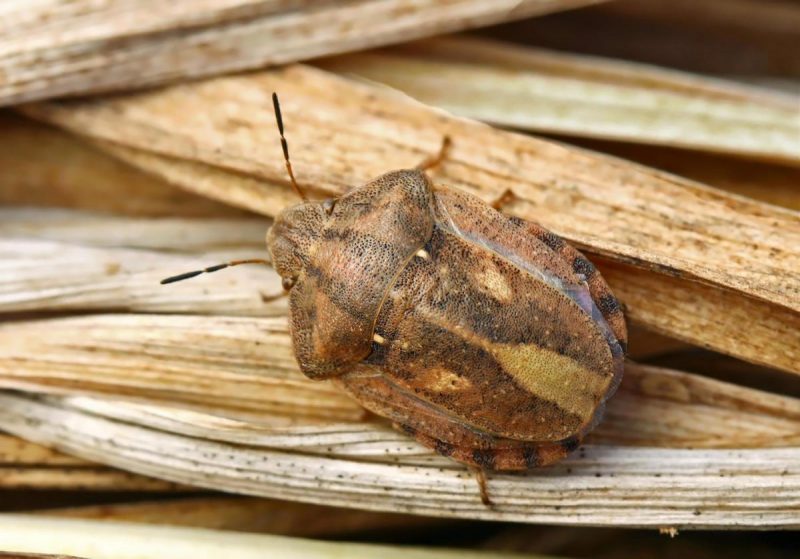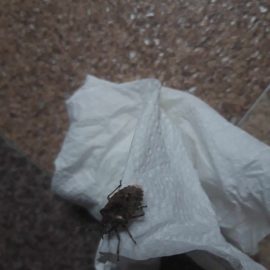The sunn pest (Eurygaster integriceps) – pest management

The sunn pest or corn bug, Eurygaster integriceps is a pest widespread in northern Africa, the Balkans, and Western and Central Asia.
Description
Adults have an ovoid appearance, with a body length of 11-13 mm. The color variation is large, from yellow-brown to completely black. The head is triangular and has a trilobate anterior extremity, this character being important in identifying the species. The antennas are long. The scutellum is well developed, sometimes protruding from the top of the abdomen and covering the wings. The egg is spherical, greenish when laid and as the embryo develops, it darkens in color. The larvae, after hatching, are almost spherical and by going through the 5 stages until maturity, they become more and more similar to adults but are smaller in size and without wings.
Biology and ecology
Sunn pest produces one generation a year and overwinters in the adult stage under the leaves in broadleaf forests. It becomes active in spring when the average daily temperature is between 10° C and 15° C. However, the mass migration begins when the average temperature reaches 18-20° C, favored by warm weather and lack of precipitation. After migrating on spontaneous grasses and wheat, the corn bugs go through a period of feeding and sexual maturation. Copulation and egg-laying follow. The laying of the eggs takes place at the end of May and at the beginning of June, on leaves, stems, but especially on the newly sprouted spikes. A female can lay 70-100 eggs, depending on her fat reserve. The incubation of the eggs lasts 7-20 days, after which the 5 larval stages follow, until the adult stage (30-40 days).
After the migration of the corn bugs on crops, their harmful character is manifested, in May-July.
The larvae that appear after the formation of the spikes feed on the grains in the milk/wax stage.
Adults feed intensely on wheat grains for 10-12 days to accumulate as many reserves as possible. The reserve substances are necessary for the vital processes during the diapause and multiplication period. The period of intense feeding overlaps with the full ripening of the wheat crops, and therefore, with its harvesting.
After gathering the necessary reserves, the adults migrate to enter the diapause under the leaves of deciduous trees, until the following spring. Usually, the development cycle ends before the wheat is harvested.
Thus, the processes from the exit of the diapause period and until the full development of the adults are favored by the hot, dry, windless weather, along with a strong light. On the contrary, the cold, humid weather, with strong winds inhibits their normal development, with negative consequences on the population’s numbers.



Attacked plants and damage
It is an oligophagous species, growing mainly on wheat but also attacking other cultivated and spontaneous grasses. The attack comes in stages from the end of April until the harvest. All parts of the plant are attacked: stem, leaf, spike, grains.
The attack is different depending on the generation. Hibernating adults feed on plant organs, the attacked leaves turn yellow, twist, and dry at the point of stinging. The attack on the stem, when the spike is still undeveloped, can lead to the spike falling.
The larvae and young adults feed exclusively on the spike grains.
A small swelling called a “salivary cone” forms after the sting. A yellow area appears around it. Sometimes the spike remains on the stem and when it develops, it has wavy edges and can be totally or partially sterile, whitish. The attacked grains are ridgy and bear the sting marks in the form of black dots, surrounded by a discolored area. The stings produced by bugs lead to weight reduction, to the decrease of the economic value of the seeds, and especially to the depreciation of the baking qualities of the attacked crop. The enzymes secreted by the bugs and introduced into the grain during the feeding process lead to gluten degradation and loss of elasticity.
They attack the aerial parts of the plant, predominantly the leaves and stem, which leads to quantitative losses. The attack of larvae and adults of the new generation is targeted almost exclusively on the grains, causing qualitative losses.
Control
At present, chemical control is the only effective method of protecting crops against this pest.
For control actions planning, the annual forecast of the appearance of the sunn pest is elaborated. This is done by estimating the populations in a certain area. It takes into account the density of the existing sunn pest in straw cereal crops before harvest and the frequency of the attacked grains. In deciduous forests, inspections are carried out in autumn and spring to assess the reserve of adult bugs.
Recommended products
-
You can find products on a different store
Change Store -
You can find products on a different store
Change Store -
You can find products on a different store
Change Store -
You can find products on a different store
Change Store -
You can find products on a different store
Change Store -
You can find products on a different store
Change Store -
You can find products on a different store
Change Store -
You can find products on a different store
Change Store -
You can find products on a different store
Change Store -
You can find products on a different store
Change Store -
You can find products on a different store
Change Store -
You can find products on a different store
Change Store -
You can find products on a different store
Change Store -
You can find products on a different store
Change Store -
You can find products on a different store
Change Store -
You can find products on a different store
Change Store -
You can find products on a different store
Change Store -
You can find products on a different store
Change Store -
You can find products on a different store
Change Store -
You can find products on a different store
Change Store -
You can find products on a different store
Change Store -
You can find products on a different store
Change Store -
You can find products on a different store
Change Store -
You can find products on a different store
Change Store
Economic threshold
For the new generation, the economic threshold is established according to the number of larvae in stages I and II. Thus, 5 specimens/m² for crops with optimal density, well-fertilized, and with the plant phenology corresponding to the month in which the survey was conducted. Three specimens/m² for crops without optimal density, improperly fertilized. In crops intended for seed production, the economic threshold is 1 specimen/m².
It is recommended to cultivate early maturing varieties to reduce the impact of new adults on crops. The earlier harvesting of crops is also recommended, in favorable climatic conditions.
Chemical control is done with specific insecticides, taking into account the density of the pest, the vegetation period, and the climatic conditions of the respective year.

















































































































































































































































































































































































































































